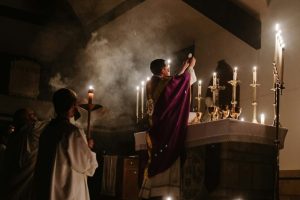Books have a special way of opening our imaginations to moments of grace in life.
Catholics are a sacramental people. We see signs of the presence of God around us in every moment of our lives. We know, of course, that God is greater than we can imagine and beyond all that we can touch, but we are also convinced that creation, from the most ordinary—water, oil, bread—to the most unlikely—the stranger, the enemy, the cross—can reveal divine love.
This is the ideal—to see God all around us—yet in our daily lives it is all too easy to sleepwalk our way past revelatory moments. We are so busy, so frantic, so distracted, that we miss much of what is going on around us.
If we really want to live as a sacramental people, we need to deliberately cultivate the habit of waking up to the presence of God, and to do that we need to cultivate our imaginations. We need to develop the insight and judgment to understand what is happening around us. One way to do this is to look to the stories we tell one another.
Storytelling has always been a central way human beings have taught each other about how the world works. Indeed, Jesus told stories-parables-that troubled and confused people. He turned their assumptions upside down, inviting them to look at the world from a new perspective, to imagine reality in a new way.
Today’s writers and storytellers, too, invite us to look at the world from a new perspective, to see things in a way we had not previously imagined. Literature can be one of our teachers as we develop and educate our imaginations.
I teach theology at a Catholic university, but most of my students are majoring in subjects such as nursing, education, and social work. Many assume that theology is far from practical. One way I pull them into it is by including a novel among our theology texts. Discussing suffering or the will of God or forgiveness works much better when we have the anchor of a common story. We then move from literature to our own lives, and we find our imaginations stretched and reshaped as the experiences of others open our eyes to new ways of seeing and understanding the world around us.
One of my favorite novels for introducing students to the idea of finding the presence of God all around us is Marilynne Robinson’s lyrical and lovely Gilead (Picador, 2004). The novel is structured as a letter from John Ames, an elderly pastor in 1950s Iowa, to his small son as an attempt to tell him all the stories and musings and memories that he will not get a chance to pass on, as Ames knows he is dying.
One memory that Ames comes back to again and again is his father sharing a piece of biscuit with him after a long day of helping to pull down a church that had been struck by lightning. Ames was a small boy at the time, and the memory of the burned church, the rain, the solemn burial of ruined Bibles, and the simple sharing of a soot-covered biscuit was central to forming his imagination of community, church, and Eucharist.
In class we discuss this scene and its echoes throughout the story, and connect it to our own experiences of food, family, and church. We begin to see, as Ames did, that sometimes our experience of communion is shaped by our experience of other meals, and sometimes our experience of a “normal” meal is shaped by our experience of communion.
But a novel does not have to explicitly model such reflection for it to feed our sacramental imaginations. In my introductory class in theology, we spend an all-too-brief time learning a few basics about the world’s great religions. I encourage my students to do more than read from their assigned textbook; I bring in a stack of novels.
If they’d like to think more deeply about Islam, then Mojha Kahf’s The Girl in the Tangerine Scarf (PublicAffairs, 2006) might interest them. I describe a few of Chaim Potok’s novels for those who might want to pursue an interest in Judaism, and for those who want to tackle the complexities of daily life and religion in India, I suggest Rohinton Mistry’s A Fine Balance (Vintage, 2001). Louise Erdrich’s novels are of particular interest to my students, as she writes about Minnesota and both Ojibwe and immigrant Minnesotans. I suggest memoirs as well as novels, and the occasional history or historical fiction.
There is also literature that educates our imaginations because it demands that we see love–and God–in places where they seem absent. This is a powerful gift for the sacramental imagination. Kate Braestrup’s gorgeous memoir Here if You Need Me (Little, Brown, and Company, 2007) describes not only her work as a chaplain for Maine game wardens but how she came to that work after, and ultimately because of, her husband’s death.
In 1996 Braestrup’s husband, Drew, a Maine state trooper, was killed in a car accident while on duty. She was left a widow with four children under the age of 10. Braestrup asked to bathe and dress her husband’s body, something that a wife would have done once upon a time but is a shocking thing to ask to do today. Braestrup herself admits that she was frightened and uncertain: “What if my beloved’s corpse disgusts me?” she thought. “What if seeing him and touching him make it hurt more?” But she insisted on bathing and dressing him, closing the coffin for the last time by herself, and attending the cremation.
We have no experience to guide us, yet by instinct as well as by a more intellectual conviction, I knew that I had to walk up to that which would hurt me most: Drew’s body without Drew in it. I wanted to do it not because it would help me heal–healing was both indefinable and unimaginable–but because it was the authoritative command of an authentic love.
To tend the body of the beloved—this is one of the most ancient human gestures; it goes back nearly 100,000 years, long before most of the behaviors we recognize today as markers of modern humanity. We may not have the experience today to do this—we have left it to professionals for generations now—but we still recognize the inclination, and we recognize the importance of tending our dead.
At the funeral home, the door of the cool, ordinary room was opened, and there he was. He was dead. And I will not lie, he looked dead. But it was comfort, joy, and sweet relief, not horror or pain, to see his body there. Drew lay on a white-enameled steel table. . . . Tom, my mother, the two sergeants, and I dressed his body gently in a Class A Maine State Police uniform, crying a little, but laughing a little, too. It’s absurdly difficult to put clothing onto a body that cannot cooperate, and what was there to do but imagine Drew’s amusement at this necessary indignity and laugh with him? . . .
I washed Drew’s face with a soft, damp cloth. This is what Drew would have done for me, I thought. And in all the time I shall live without him–time roaring and tumbling at me like some merciless, black avalanche—I will be able to tell myself that I bore our love with my own hands all the way to the last hard place. “Semper fidelis,” I told him, washing him tenderly around the mouth and jaw and closed eyes, then smoothing his hair with my hand. Leaving the cool room where Drew’s body lay was harder than it was to enter it.
When I ask my students to write a short reflection in response to the first several chapters of Braestrup’s book, almost everyone writes about this scene. It is compelling, fascinating, beautiful, strange. We talk about it in class at great length, and students tell stories of the deaths of parents and grandparents, of being able to touch the body of the beloved or of being too frightened, too filled with grief, to be able to do so. They are drawn to the notion of tending the body of the beloved, and wonder aloud if they would have the courage, if they could make the same kind of choice Braestrup did.
As Braestrup’s readers, my students find themselves imagining a startling new possibillity: We, too, could do what she did. We, too, might choose to care for the bodies of our loved ones when they die. Will this change their actual behavior when they are at last confronted with a death? I have no idea, but I do know this: They now have Braestrup’s choices, her love and her courage, as a model, a framework, a possibility. What the world is really like—what is possible in this world—has shifted for them (and for us).
Reading novels may not strike us as the most obvious spiritual practice. And yet reading, considering, judging, and discussing novels and stories trains and expands our imaginations, and thus our ability to see clearly and interpret appropriately what is happening in the world around us. We are striving for a sacramental understanding of our lives, one in which we are awake to the presence of God. That presence embraces us, changes us, and brings us to union with Christ. It is no small task to gain such a sacramental understanding of life; it is indeed the task of our lives.
One way to describe such a life is in these words by writer Terry Tempest Williams from her collection of essays Red (Vintage, 2002):
I am home in the desert. There are steep canyons before me carved away by water, by wind. I see an opening in the earth. I feel an opening in my heart. My hands cradle red dirt and I watch it slip through my fingers, creating a small rise on the land. To be present, completely present, in these tender and uncertain days. This is my prayer: to gather together, to speak freely, to question and be questioned, to love and be loved, to feel the pulse, this seismic pulse—it will guide us beyond fear.
In the end, this is what is really going on; this is where our imaginations can lead us; this is where we as Christians are called to live. Beyond fear. At home. At home, in a place that is both beautiful and scarred, a place where our hearts are open and we are present to the life and death around us. Like the times in which we live, we are tender and uncertain. Like the red dirt slipping through Williams’ fingers, we are falling. Like those who tend the grieving, we are gathered together, holding one another up, questioning, loving, seeking.
A sacramental understanding of the world leads us here, where we find ourselves surrounded by what is absolutely ordinary (water, bread, family) and what is startlingly unexpected (strangers, grief, the cross)—and we know at last that all of this is a visible form of the invisible grace that is the love of God.
This article appeared in the October 2010 issue of U.S. Catholic (Vol. 75, No. 10, pages 22-24).















Add comment